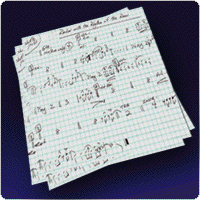Transcribing
We all have to learn new material. You can sit and listen to a tune until you memorize it, and that's fine for you, as an individual player. But, if you transcribe a reasonably accurate chart for the tunes you're working on in your band, there are other advantages... It's not all "about you", right?
With a transcribed part, like the samples on the Fast Parts page, here's what you get:
 Of course, reading, by itself, will not make you "better". BUT... It will make enable you to learn more material faster, and to do it more accurately. In those emergency situations where you have to join a band sooner than expected, being able to write a bunch of simple charts can make you a real "hero" on the first night of the job. Those people that don't read will wonder how you "learned" so many tunes so quickly and accurately.
Of course, reading, by itself, will not make you "better". BUT... It will make enable you to learn more material faster, and to do it more accurately. In those emergency situations where you have to join a band sooner than expected, being able to write a bunch of simple charts can make you a real "hero" on the first night of the job. Those people that don't read will wonder how you "learned" so many tunes so quickly and accurately.- For yourself, you have a reference that will refresh your memory, which you can pull out years later, if need be. (for example, when one band drops the tune, but the next band you play with still does the tune)
- At rehearsal, you'll know if the other players really learned the details, because you'll have the "kicks" written out. If they didn't learn the parts, you can then explain it to them.
- By writing these very simple charts again and again, you learn a different way to visualize music, and you understand it's major structures. Of course, you gain this anyway, over time, whether you read or not, but if you read, you can learn them faster.
- If you can transcribe (copy) drum parts, then you can also do other writing-related projects, like writing down your favorite drummer's "licks", analyze and study material you've never heard before, by reading music books, and pass on your own ideas to others. (like I'm doing here)
- If you have drummer friends that read, you can let them use your book (or a copy) if they're subbing for you, or replacing you.